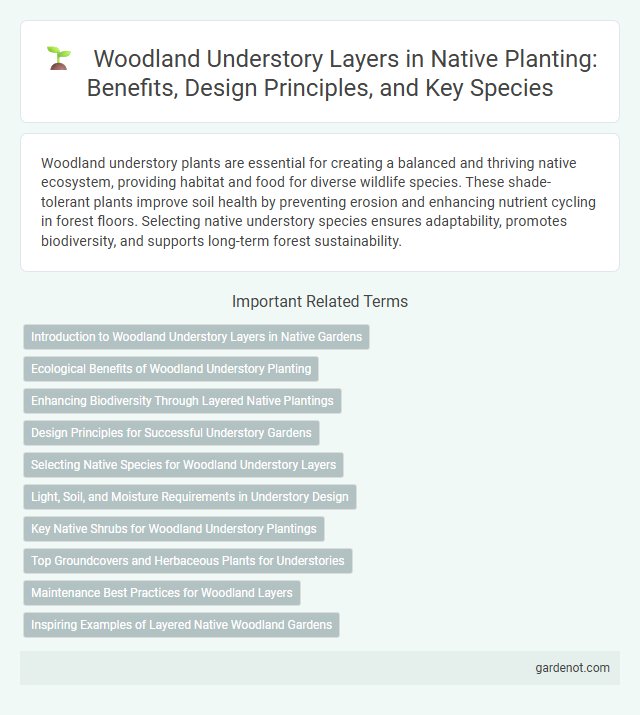Woodland understory plants are essential for creating a balanced and thriving native ecosystem, providing habitat and food for diverse wildlife species. These shade-tolerant plants improve soil health by preventing erosion and enhancing nutrient cycling in forest floors. Selecting native understory species ensures adaptability, promotes biodiversity, and supports long-term forest sustainability.
Introduction to Woodland Understory Layers in Native Gardens
Woodland understory layers in native gardens consist primarily of shade-tolerant shrubs, herbaceous perennials, and groundcovers adapted to filtered light beneath the forest canopy. These plants contribute to biodiversity by providing essential habitat and food sources for pollinators, birds, and small mammals. Incorporating native understory species like trilliums, ferns, and spicebush ensures a resilient, ecologically balanced garden ecosystem that mimics natural woodland processes.
Ecological Benefits of Woodland Understory Planting
Woodland understory planting enhances biodiversity by providing essential habitats for pollinators, birds, and small mammals, contributing to a balanced ecosystem. These native plants improve soil health through nutrient cycling and erosion control, supporting tree root systems and water retention. Understory vegetation also aids in carbon sequestration, mitigating climate change effects and promoting forest resilience.
Enhancing Biodiversity Through Layered Native Plantings
Woodland understory plays a crucial role in enhancing biodiversity by providing diverse habitats through layered native plantings, which include shrubs, herbaceous plants, and groundcovers. These stratified layers support various pollinators, birds, and small mammals, creating ecological niches that increase species richness and ecosystem resilience. Implementing native understory plants such as ferns, trilliums, and spicebush promotes soil health, moisture retention, and natural pest control within forest ecosystems.
Design Principles for Successful Understory Gardens
Selecting native plants that thrive in shaded woodland conditions ensures a resilient and low-maintenance understory garden. Layering vegetation with varying heights and textures mimics natural forest structures, promoting biodiversity and habitat for pollinators and wildlife. Incorporating soil health practices and moisture-retentive mulches supports root development and reduces erosion in understory environments.
Selecting Native Species for Woodland Understory Layers
Selecting native species for woodland understory layers enhances biodiversity and ecosystem resilience by providing habitat and food sources for local wildlife. Key native plants include shade-tolerant species such as trilliums, wild ginger (Asarum canadense), and mayapple (Podophyllum peltatum), which thrive under forest canopies. Incorporating diverse native ground covers, shrubs, and herbaceous plants supports soil health and helps prevent invasive species from establishing.
Light, Soil, and Moisture Requirements in Understory Design
Woodland understory plants thrive in filtered light conditions, preferring partial to full shade environments beneath mature tree canopies. These plants require well-drained, nutrient-rich soils with a slightly acidic to neutral pH, fostering healthy root development and nutrient uptake. Moisture levels should be consistent but not waterlogged, with moderate to high humidity supporting diverse understory vegetation commonly found in native forest ecosystems.
Key Native Shrubs for Woodland Understory Plantings
Key native shrubs for woodland understory plantings include spicebush (Lindera benzoin), witch hazel (Hamamelis virginiana), and witch alder (Fothergilla gardenii), which thrive in shaded, moist environments. These species provide essential habitat and food sources for wildlife while supporting soil health and biodiversity. Selecting native shrubs adapted to local woodland conditions enhances ecosystem stability and resilience.
Top Groundcovers and Herbaceous Plants for Understories
Top groundcovers like Vinca minor and Pachysandra terminalis provide dense, low-maintenance coverage that suppresses weeds and retains soil moisture in woodland understories. Herbaceous plants such as Trillium grandiflorum and Solomon's seal (Polygonatum biflorcatum) thrive in shaded environments, adding seasonal interest and supporting local pollinators. Incorporating diverse species like wild ginger (Asarum canadense) enhances soil health and creates a resilient, ecologically balanced understory layer.
Maintenance Best Practices for Woodland Layers
Maintaining a healthy woodland understory requires regular monitoring of invasive species to prevent their spread and protect native plant diversity. Practices such as selective thinning and mulching support soil moisture retention and reduce competition for nutrients among native shrubs, ferns, and herbaceous plants. Seasonal pruning encourages robust growth, while avoiding heavy machinery prevents soil compaction and preserves root structures essential for woodland ecosystem stability.
Inspiring Examples of Layered Native Woodland Gardens
Layered native woodland gardens showcase diverse understory plants such as trilliums, bloodroot, and wild ginger, creating multi-dimensional habitats that support pollinators and wildlife. Incorporating native ferns and shade-tolerant shrubs like spicebush enhances soil health and moisture retention while adding texture and seasonal interest. These examples demonstrate the ecological benefits and aesthetic richness achievable through thoughtful layering of native woodland species.
Woodland understory Infographic

 gardenot.com
gardenot.com